


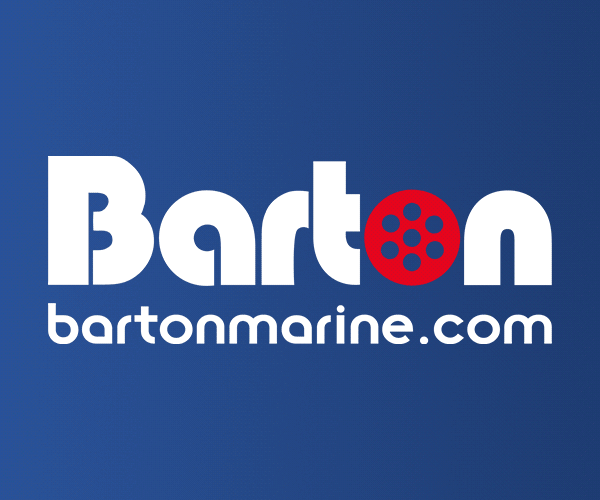





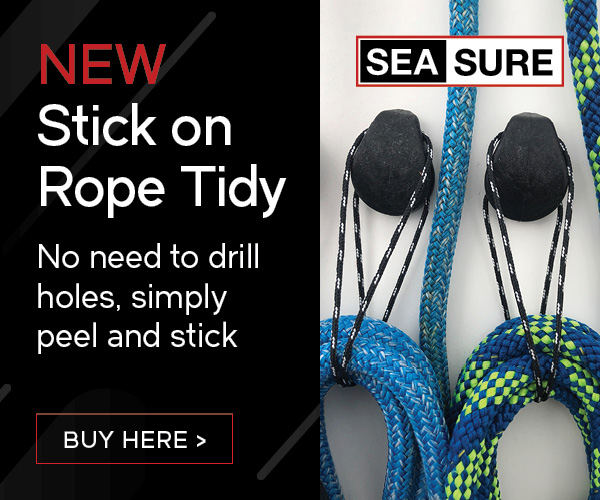
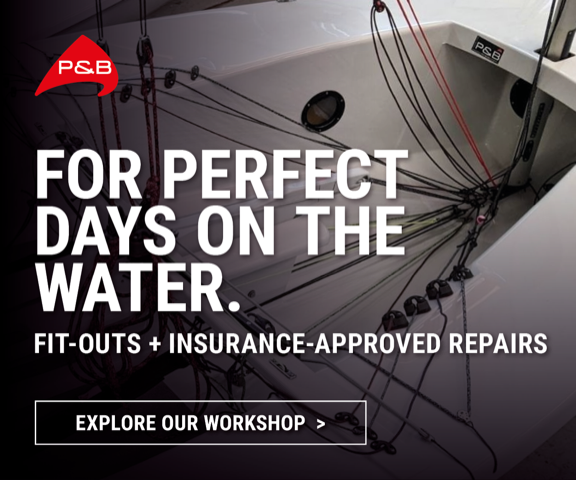


Boats for sale
| Laser 140101 Tynemouth |
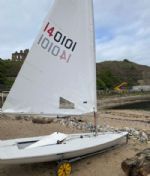 |
| Laser 28 - Excellent example of this great design Hamble le rice |
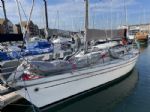 |
| Rossiter Pintail Mortagne sur Gironde, near Bordeaux |
 |
List classes of boat for sale |
How to Stop |
Post Reply 
|
Page 12> |
| Author | |
ColPrice2002 
Far too distracted from work 
Joined: 25 Nov 08 Location: United Kingdom Online Status: Offline Posts: 222 |
 Post Options Post Options
 Quote Quote  Reply Reply
 Topic: How to Stop Topic: How to StopPosted: 11 Aug 18 at 12:53pm |
|
Agreed.
The Argo needs the mast and jib to be raised ashore. We get the jib luff tension using 2 people. The heavier person stands on the launching trolley handles, grabs the forestay (gloves really useful) and pulls the forestay outwards as hard as possible. Person 2 hoists jib and pulls halyard into cleat (clamcleat). Then the forestay is untied from the stemhead and tied to the mast support beam. I usually put a piece of adhesive tape over the jib halyard just below the cleat. It reminds me not to uncleat the jib before replacing the forestay... (Everyone's done it once!) Colin |
|
 |
|
craiggo 
Really should get out more 

Joined: 01 Apr 04 Location: United Kingdom Online Status: Offline Posts: 1810 |
 Post Options Post Options
 Quote Quote  Reply Reply
 Posted: 10 Aug 18 at 10:10pm Posted: 10 Aug 18 at 10:10pm |
|
Is the OP trying to raise the mast and sails on the water or on the trolley?
If trying to do it on the water then I suggest doing it all on the trolley ashore, you can then get the boating pointing head to wind and you have space to avoid the swinging boom. Once rigged up walk the trolley into the water and pass the painter (rope from the bow to someone on the dock who can walk it out. Have a long line on the trolley back up the ramp and retrieve your trolley before joining the others on the dock. A fair bit of gnav and outhaul tension while launching will reduce some of the swinging boom but once everyone is in and you are ready to move away it's wise to ease the gnav a bit until you have everything sorted and under control. |
|
|
OK 2129
RS200 411 |
|
 |
|
ColPrice2002 
Far too distracted from work 
Joined: 25 Nov 08 Location: United Kingdom Online Status: Offline Posts: 222 |
 Post Options Post Options
 Quote Quote  Reply Reply
 Posted: 10 Aug 18 at 9:00pm Posted: 10 Aug 18 at 9:00pm |
|
Thanks for the update...
There is a "manual" available for the Argo online, that may help. The Argo forestay is really only needed to keep the mast up without the jib. I find the Argo excellent for teaching, but certainly raising/lowering the mainsail is always a pain... Outhaul:- This controls the amount of curve (draft, draught, belly) in the sail. Look up aerodynamics (NASA) for a long description. Basically, flat sail = little drive from the sail; more curve = more power. Start with a hand span of curve, as the wind increases, you can flatten the sail to reduce the power & heeling effect. Gnav No tension allows the boom to rise, this means that only part of the sail is at the optimum angle to the wind. More tension, and more of the sail is at optimum angle. Lots of tension will bend the mast, this makes the sail flatter and you have another way of depowering the rig... That's a basic overview, try different settings and see what happens! Colin
|
|
 |
|
JimC 
Really should get out more 

Joined: 17 May 04 Location: United Kingdom Online Status: Offline Posts: 6662 |
 Post Options Post Options
 Quote Quote  Reply Reply
 Posted: 10 Aug 18 at 4:21pm Posted: 10 Aug 18 at 4:21pm |
|
The other downside of leaving the jib up all the time is UV damage. Some yacht sails have a dark band sewn to the leech and foot to protect.
|
|
 |
|
423zero 
Really should get out more 
Joined: 08 Jan 15 Location: United Kingdom Online Status: Offline Posts: 3420 |
 Post Options Post Options
 Quote Quote  Reply Reply
 Posted: 10 Aug 18 at 4:14pm Posted: 10 Aug 18 at 4:14pm |
|
Tom,
Yachts tend to leave furled jib up, you need to keep it fairly tight though, wind will pick it to ribbons, frost can also damage sails |
|
 |
|
tomjv 
Newbie 
Joined: 27 Aug 17 Location: somers,ny Online Status: Offline Posts: 16 |
 Post Options Post Options
 Quote Quote  Reply Reply
 Posted: 10 Aug 18 at 2:05pm Posted: 10 Aug 18 at 2:05pm |
|
Thanks! Colin for the detailed post. That's all good info and technique for me to try out.
The Argo definitely sets up easier with two people. What I've been doing to make things faster/easier is; I rig the jib first thing(furled or not). Then, my wife (crew) steps inside the craft, raises/holds the mast with me assisting on the jib haul line. Cleat and sweat and she's up. I thinking about just removing the forestay altogether. If I'm ever alone, I can use any line for that temporary rigging. I just adds more clutter on a valuable piece of real estate(bottom of the mast haha). Is there anything wrong with stowing the jib furled? When I'm "up to camp" sailing, I like to leave it this way between sails. this is a week at a time. When I leave, I unfurl it slightly to allow air inside. I'm on fresh water. Can you explain about the relationship of the outhaul and Gnav? I use both, but I'm not certain how they work together. I think I've been cleating the outhaul, then the GNAV, in that order. As for stopping, I'm going to try your suggestion; lie to. One major problem with my Argo is, on mine, the GNAV is on the starboard side and the halyard on the port. So, if you're standing on the port side to manipulate the halyard, you have trouble reaching the GNAV/battens. The problem with facing into the wind(with the wind on the GNAV side, to relieve the binding) is the boom swings over the port beam, making it impossible to manipulate the haul line. Don't forget, it's not a perfect world. Sometimes things bind when dropping the main and you need to raise it an inch or two to get it going again. But I'm new at this stuff! I definitely want to take a class. There should be PLENTY near me. I live in NY, a hour north of Time Square. It's just the time . . . Thanks Again! TomJV
|
|
|
TomJV
|
|
 |
|
ColPrice2002 
Far too distracted from work 
Joined: 25 Nov 08 Location: United Kingdom Online Status: Offline Posts: 222 |
 Post Options Post Options
 Quote Quote  Reply Reply
 Posted: 09 Aug 18 at 5:56pm Posted: 09 Aug 18 at 5:56pm |
|
HI, Welcome to the fun of sailing:- Rigging - Argo The Argos I've used have a jib furler fitted (it's in the beam under the jib tack, consists of a drum with control line wound on it. Head of the jib is a swivel fitting, pull on the control line - cleat just under the mast beam - and the jib will win up around the jib luff). Setting up the Argo I find difficult - you need to get the jib luff really tight (2 person job really!), then untie the forestay from the front and tie it out of the way (it fouls the jib furler if you don't!) Ok, Furk the jib, turn the boat on trolley head to wind and raise the mainsail. For launching you'll want little drive, so pull the outhaul on lots to flatten the sail, no tension on the Gnav. Add the rudder, then walk the trolley into the water (taking all the precautions mentioned above) until the boat floats off. You're probably up to your waist by now... If you have help, 1 person holds the boat head to wind, other person takes trolley ashore. If not, you may be able to manage holding the boat and pull the trolley at the same time. Otherwise, the small anchor/grapnel is an excellent way of stopping the boat going anywhere while you recover the trolley. Choose the best direction to start, walk aboard (over the stern!), and sail off gently lowering the centreboard and rudder as the water gets deeper. Once you have control, ease the mainsail outhaul and add some tension to the Gnav. When happy, release the jib furler, tug on the jib sheets and away you go. (tie the jib sheets ends together for single handed sailing). Stopping. Practice well away form the shore as follows:- a) sail on a close reach (about 70 degrees into the wind) b) release jib and let the mainsail out as far as possible the mainsail shouldn't be pulling - if it is, turn a little more into the wind. You'll stop (eventually) with the wind blowing over the side of the dinghy. To get going again, just pull the sheets in. (stopping head to wind works as well, but is harder because you'll star blowing backwards...) You can use this technique to land almost anywhere (or come alongside another boat, jetty, buoy, man overboard). if you're coming downwind onto a lee shore, aim about 5-8 boatlenghts to one side, then "lie to" as above. Alternatively, you can drop the mainsail - 1) choose a nice spot, clear of obstuctions 2) furl the jib (the boat will want to turn into the wind) 3 (as above) stream the main halyard over the side of the boat (stops it making knots) 4 turn head to wind with the wind on the port side (the Gnav is just to the left of the sail track, you want the sail to blow away from this as it comes down - reduces the batten problem!) 5) drop mainsail. 6) unroll jib, and back it to help turn the dinghy downwind. Aim for the landing spot, at a suitable distance. roll the jib, release the rudder downhaul raise the centreboard (not all the way) and drift in. The disadvantage of this method is that you are totally committed to the landing. With the first method, you can always sail away and go for plan B, Plan C etc. From what you're writing, you would find one of the RYA Courses (Level 3 - better sailing or Seamanship skills) helpful. I suspect that you may have to travel! Anything unclear, please come back - our local sail training centre has Argos and I can always take a few photos. The Zuma isn't popular in the UK, but it looks like a number of smallish dinghies. Regards, Colin |
|
 |
|
Sam.Spoons 
Really should get out more 
Joined: 07 Mar 12 Location: Manchester UK Online Status: Offline Posts: 3401 |
 Post Options Post Options
 Quote Quote  Reply Reply
 Posted: 08 Aug 18 at 8:02pm Posted: 08 Aug 18 at 8:02pm |
|
I usually sail in and round up in the shallows but that is off a sandy beach (called "Sandy Beach" in a fit of madness ;) )
|
|
|
Spice 346 "Flat Broke"
Blaze 671 "supersonic soap dish" |
|
 |
|
423zero 
Really should get out more 
Joined: 08 Jan 15 Location: United Kingdom Online Status: Offline Posts: 3420 |
 Post Options Post Options
 Quote Quote  Reply Reply
 Posted: 08 Aug 18 at 6:35pm Posted: 08 Aug 18 at 6:35pm |
|
I have been sailing from and to a Lee shore for 10 years, when I first started I tried all sorts of things, most successful was sailing in backwards, I now just sail in without even thinking about it, a boom push is easiest way to leave but you need someone on shore.
|
|
 |
|
JimC 
Really should get out more 

Joined: 17 May 04 Location: United Kingdom Online Status: Offline Posts: 6662 |
 Post Options Post Options
 Quote Quote  Reply Reply
 Posted: 08 Aug 18 at 4:05pm Posted: 08 Aug 18 at 4:05pm |
|
By get off a run all I mean is sailing on a broad reach, not directly downwind. Once you are sailing on something approaching a beam reach with just the jib it feels really odd, because you'll need the tiller pushed well to leeward just to sail straight, but it will work. The key is patience, because it takes the boat a long time to get going, and if you loose speed time to build it up again.in order to sail reasonably across the wind you'll need to build up some speed first.
Edited by JimC - 08 Aug 18 at 4:10pm |
|
 |
|
Post Reply 
|
Page 12> |
| Forum Jump | Forum Permissions  You cannot post new topics in this forum You cannot reply to topics in this forum You cannot delete your posts in this forum You cannot edit your posts in this forum You cannot create polls in this forum You cannot vote in polls in this forum |
Bulletin Board Software by Web Wiz Forums® version 9.665y
Copyright ©2001-2010 Web Wiz
Change your personal settings, or read our privacy policy
Copyright ©2001-2010 Web Wiz
Change your personal settings, or read our privacy policy












 Printable Version
Printable Version Delicious
Delicious Digg
Digg Facebook
Facebook Furl
Furl Google
Google MySpace
MySpace Newsvine
Newsvine reddit
reddit StumbleUpon
StumbleUpon Twitter
Twitter Windows Live
Windows Live Yahoo Bookmarks
Yahoo Bookmarks Topic Options
Topic Options